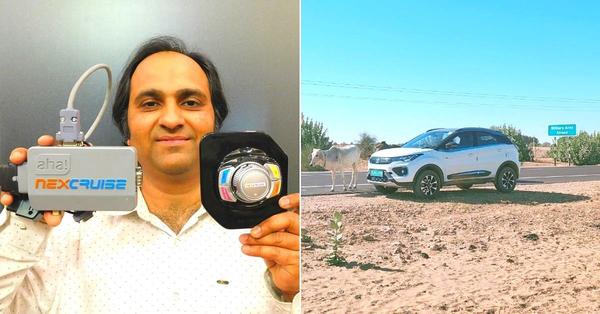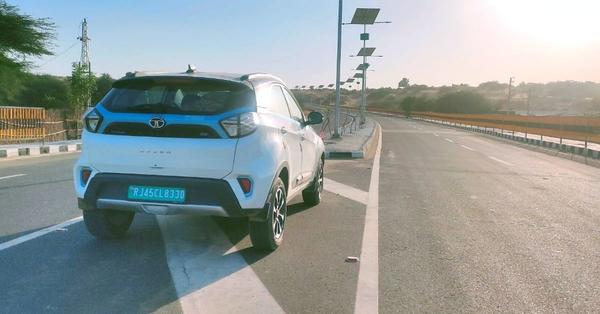
This article is part of a deep dive into Electric Vehicles in India. #EVinIndia is the first chapter of ‘Shaping Sustainability’, an exclusive series by The Better India to give our readers an in-depth understanding of how Indians are making sustainability a priority in all walks of life. Find more stories from the series, here.
For four days in late December 2020, Aakash (no surname)—the founder of Jaipur-based Aha 3D innovations that designs 3D printers—went on a road trip with his wife Kaushal in his Tata Nexon electric vehicle (EV), which has a premium battery range of 312 km.
This was a 1500 km roundtrip from Jaipur to Longewala on the India-Pakistan border, which saw the couple passing through Pushkar, Jodhpur and Jaisalmer. While this road trip garnered much media attention for spending Rs 800 to charge their vehicle (fuel costs), it also became the starting point for a unique innovation that maximises the battery range of a four-wheeler EV.
Advertisement“We got to experience all the challenges associated with long-distance travel in EVs first-hand on this road trip and found manual tricks to work around issues of battery range anxiety. After learning the necessary intricacies, I realised that all of this can be automated. A computer can easily be programmed to do all the tedious work, and leave the user to just enjoy the fruits of driving an EV,” says Aakash, in a conversation with The Better India.
The Aha NexCruise, a plug-and-play device, takes the pain out of driving and maximises the range of an EV when going long distances on roads with no fast chargers.
“When we are driving it in an energy-efficient way or doing ‘the EV style of driving’, it’s a lot of work. We need to constantly monitor the speed of the car, the energy it is consuming, and accordingly keep operating the accelerator pedal to a very high level of accuracy. The penalty for not doing it is huge. Getting distracted even for small periods results in penalties like losing 10 km range even before we realise it because the car is so smooth in picking up speed. With everything else remaining the same, you can get a battery range anywhere between 150 km to 340 km on a single charge, depending on your driving style. This disparity can be totally rectified with the NexCruise,” he claims.
AdvertisementOrigin Story
Starting out, Aakash, an electronics engineer by trade, felt that the development of such a device would make highway driving accessible to all EV owners and may contribute to faster adoption of this electric mobility technology.
“When the second COVID-19 induced lockdown happened and disrupted our regular work, I was left with ample time and decided to explore if such a device can be developed. The prototype didn’t take long to come. I posted this effort in the form of a YouTube video, and since then things have snowballed. From the ideation stage to the production of this device it took us 8 months. Today, the device costs Rs 26,000 (plus taxes),” says Aakash.
AdvertisementThe Aha NexCruise brings cruise control and other hosts of features to your EV and enables you to confidently drive long distances with no fast chargers.
“Normally, low-budget EVs are propounded as city cars only because of limited battery capacity. But EVs are still costly and to achieve full value-for-money, they have to be driven more to offset the initial cost. By allowing the users to still take them on a long-range with reliability, this device opens a new possibility of faster EV adoption at a mass scale,” says Aakash.
But where do you install it in your EV? Normally, the accelerator pedal is directly connected to the vehicle control unit (VCU) of the car using a detachable connector. Consumers can insert this device between the accelerator pedal and the VCU.
Advertisement
“So now, the accelerator-pedal signal is received by the device instead of directly going to the car. And the device, in turn, refines this signal as per the rules of ‘the EV style of driving’, and delivers this ideal signal to the VCU of the car. Hence, it insulates the car from all manual mistakes, and helps achieve the best possible range,” he explains.
All features, i.e. cruise control, coast mode, eco and deep eco modes, are offered by this device via this simple methodology. For the time being, it’s only for four-wheeler EVs, but it can be developed for two-wheelers too on the same principle.
The official range of the Nexon EV as stated by TATA Motors is 312 km. With this device, users have got up to 340 km range with their Nexon EVs, claims Aakash. EVs in general are very predictable cars. What is unpredictable is the way they are driven. This is the root cause of unpredictable range, and consequently, range anxiety. To eliminate range anxiety, users should be able to predict accurately how far the car will go in the given charge well in advance.
Advertisement“This device lets them predict the same by providing simple modes which ensure the needed range. For example, if a user must cover more than 300 km on a single charge, they can engage the ‘Deep Eco’ mode of the device. This mode restricts the power consumed by the car, and in return, gives the user full confidence that they will be able to cover the needed distance. Likewise, the cruise control feature gives the user assurance that if they use a set cruising speed, they will get a range corresponding to that speed. For example, if the user drives with cruise control at 70kmph, the car will deliver a range of 270 km or more. For cruising at 80kmph, the user always gets a range of around 240 km,” explains Aakash.
Easing the Process of Driving EVs
AdvertisementVarada Raju, a resident of Mysore and the owner of a four-wheeler EV, says, “I recently went on a roundtrip from Mysore to Bengaluru and tested the Aha Nexcruise. It made the journey very comfortable and I rarely had to use my feet for acceleration and braking.”
AdvertisementMeanwhile, Dr Manoj Singh, a resident of Delhi, mentions how thanks to the Aha NexCruise, he charges his EV once in five days as compared to four days earlier. Sushan Sikka, a fellow resident of Delhi, says, “I installed the NexCruise the same day I received it. There are many permutations and combinations one can use on this device to suit one’s needs.”
As IC-engine vehicle owners, people are used to not paying attention to the wastage of energy in our vehicles. Given how refuelling is so easy, many don’t even notice it. The moment they switch to EV, energy suddenly becomes a big deal. This is when range anxiety gets real.
“The device comes to the rescue and offers much-needed predictability for users. It avoids unpleasant experiences on highways, and gives the users clear methods to achieve the range that they’ve been counting on when deciding to purchase their car,” says Aakash.
AdvertisementThe device, he goes on to argue, has also enhanced power savings.
“Users who have long daily commutes are reporting 10 to 20% increase in range with the device. But the real savings is in the battery life itself. Typically an EV battery pack costs Rs 8 lakh and lasts for 2500 charge/discharge cycles. But since now it takes fewer charging cycles to deliver the same miles, an increase in range of the car by 15% translates to a saving of approximately Rs 1.2 lakhs for a single battery pack,” he claims.
Overcoming Challenges
Developing this device came with its challenges, particularly one major setback.
In the original design based on which Aha executed the production, the electronics noise from other vehicle fitments (horn, wiper motors etc) could find its way to the VCU through the device. This could cause potential damage to the VCU in one rare scenario.
“We could detect this design flaw well in time, but not before we had invested a huge sum into the production of the device. We took an immediate call to redo the design, scrap all the inventory, and let the order-holders know about this. This also set us back by approximately three months as compared to our previous commitments. However, with the unwavering trust and encouragement given to us by our early supporters, we emerged victorious. We also filed two patents based on our learnings that went into the product. The rollout, which was originally slated for 29 October 2021, happened on 15 January 2022,” he recalls.
So far, Aha has received orders for 400 units of the NexCruise, of which 200 have already been fulfilled. All of these users are connected on a Telegram group (https://t.me/nexcruise).
“While the design and development were carried on fully in-house, this innovation is fully powered by the community of EV users. We’ve been listening to the needs and suggestions of the users themselves, who are also the testers, validators and supporters of the product. The community is also supporting each other in installing and training activities. We wish to acknowledge the community—the pan-India Nexon EV Owners club, the NEAT Squad, and the early supporters of the product—who made this device possible by extending their full trust,” says Aakash.
There has also been a lot of subjective debate, including lawsuits, claiming that the advertised range of the car is wrong. “The device solves this problem by not only pinning down the perfect way of driving but also enforcing this through features and modes that it provides,” he adds.
The device provides the following features: